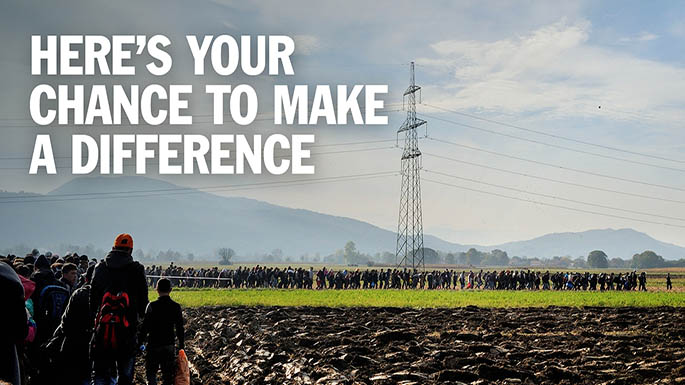Submission: May 01, 2016
Registration: May 01, 2016
Language: English
Location: Concept
Prizes: 5 winners – up to 10,000 EUR
Type: Open
The What Design Can Do Refugee Challenge is a global design competition that calls on the creative community to come up with game-changing ideas for accommodating, connecting, integrating and helping the personal development of refugees. The challenge specifically focuses on refugees in urban areas, as nearly 60 per cent of the world’s 20 million refugees now live in urban areas.
What Design Can Do (WDCD), the UN Refugee Agency (UNHCR) and the IKEA Foundation invite designers, creative thinkers and imaginative trouble-shooters from all countries and disciplines, including refugees themselves, to take part.
BACKGROUND
The year 2015 confronted the world with heartbreaking images and stories of hundreds of thousands of refugees packed into unseaworthy boats, trying to reach safer shores across the world. In most cases, for those who made it, the journey overseas was just the beginning of a long trek overland, pictures of which have also touched us.
In 2015, UNHCR revealed that the number of global forced displaced people topped nearly 60 million for the first time since the World War II. Tens of thousands of newly arrived refugees wandering across Europe, moving from one border opening to the next, triggered numerous volunteer efforts and citizen initiatives aimed at providing immediate relief.
Yet a willingness to provide long-term help is tempered by concern about the impact of mass immigration. Caught between showing solidarity and acknowledging public anti-immigrant sentiments, the European Union and individual countries are struggling to find answers to the refugee crisis.
These problems are clearly too complex for one institution alone to address. Bold and innovative ideas are needed for enduring solutions. What can designers and other creatives do to help both refugees and cities to adapt to the new reality? This is the central question behind the What Design Can Do Refugee Challenge, for which we are calling on the global creative community to make a difference.
THEME
To shape the briefs, extensive desk and field research was done to identify what experts say urgently needs to be addressed, and how these issues relate to what refugees themselves experience. These two perspectives led to important themes…
Basic needs
Basic needs, or a person’s livelihood, refers to their ‘means of securing the basic necessities of life: water, food, clothing and shelter.
Health
Refugees seeking asylum may suffer from physical symptoms related to untreated illness or wounds. Additionally, many refugees have suffered from traumatic experiences and suffer from high levels of stress related to their past, and to their uncertain future.
Connection to home
Often refugees travel alone because the journey is too dangerous to undertake with their family. For considerable time, families are separated and live far apart.
The smartphone acts as a lifeline. It allows refugees to stay in contact with family and friends, they can capture their journey and experiences, and through social media, they can share information about areas to avoid and where to find support.
Reuniting their family as soon as possible is generally the most important aim for refugees travelling alone, but this process can take long and the conditions are strict.
Mobility
Mobility is a means of contact, discovery and freedom. One of the main driving forces of refugees’ mobility is the wish to reach other family members and friends hosted in other centres, cities and countries and get to know their new living environment.
Finance
Refugees often have spent all of their money to flee from their home country to reach Europe. By the time they arrive, many have not much money left.
Before asylum is granted, access to remunerated work is very restricted in European countries, and refugees are for most part dependent on what is provided to them by the host country and volunteers.
Work
When you work, you contribute to society. Work (either voluntary or paid) allows you to stay active and be involved. Additionally, earning an income makes you independently engaged and appreciated.
The rules concerning access to work for refugees seeking asylum differ between the European states. In some countries, refugees seeking asylum are not allowed to work at all. In other countries, they can have access to work after a period of time and under strict conditions. Yet in other countries they are allowed to work. The challenge related to this topic thus differs in each European country.
Education & Training
Education is not only a platform for gaining knowledge and skills, but also the basis for integration, cultural and social exchange, mutual understanding and friendship. It is as such a key aspect for all age groups.
For children, education is a right. However, for refugee children various barriers exist. For instance, finding a place in schools near the shelter where they live.
Schools might have difficulties in addressing the special needs required to help refugee children take part in school activities. These barriers make it difficult for refugee children to receive the education they deserve.
Integration
Arriving in a host country means arriving in a totally new culture, with a new language, new customs and new (unwritten) codes. In order to participate in this new society, refugees need to integrate in the new culture.
Authorities often provide ‘basic education’ to refugees in the form of language and integration courses. Learning the new language is really key: the need to understand and speak the host country’s language is immediate from the perspective of the refugees.
Yet a willingness to provide long-term help is tempered by concern about the impact of mass immigration. Caught between showing solidarity and acknowledging public anti-immigrant sentiments, the European Union and individual countries are struggling to find answers to the refugee crisis.
These problems are clearly too complex for one institution alone to address. Bold and innovative ideas are needed for enduring solutions. What can designers and other creatives do to help both refugees and cities to adapt to the new reality? This is the central question behind the What Design Can Do Refugee Challenge, for which we are calling on the global creative community to make a difference.








